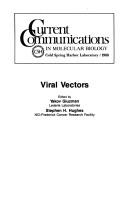| Listing 1 - 10 of 257 | << page >> |
Sort by
|
Book
ISBN: 0444904522 0444904549 0444904387 Year: 1985 Publisher: Amsterdam : Elsevier,
Abstract | Keywords | Export | Availability | Bookmark
 Loading...
Loading...Choose an application
- Reference Manager
- EndNote
- RefWorks (Direct export to RefWorks)
Book
Year: 2015 Publisher: Bruxelles: UCL. Faculté de pharmacie et des sciences biomédicales,
Abstract | Keywords | Export | Availability | Bookmark
 Loading...
Loading...Choose an application
- Reference Manager
- EndNote
- RefWorks (Direct export to RefWorks)
·L'utilisation de particules pseudo-virales (VLPs) pour l'administration de protéines antigéniques est une approche attractive. Le but de ce projet est de concevoir des VLPs fluorescentes à base de protéines structurelles gag virales couplées à la enhanced Green Fluorescent Protein (eGFP). La visualisation des VLPs permettra l'étude de leur comportement, l'évaluation de la capture cellulaire in vitro et de leur devenir in vivo.Dans ce contexte, les plasmides codant les protéines gag des virus de l'immunodéficience humaine (HIV) et de la leucémie murine (MLV) fusionnées à la eGFP, ont été clonés. Les VLPs fluorescentes, enveloppées avec la glycoprotéine G du virus de la stomatite vésiculaire (VSV-G) ou non ont ensuite été produites dans des cellules embryonnaires rénales humaines (293T) puis caractérisées qualitativement et quantitativement.La capture cellulaire des VLPs fluorescentes par des macrophages (J774) a été évaluée avec succès par cytométrie de flux . Cependant, l'évaluation in vivo des VLPs fluorescentes a été compromise par l'autofluorescence émise par la peau des souris.L'ensemble des résultats obtenus suggère que les VLPs fluorescentes produites in vitro sont captées efficacement par les cellules et pourront permettre des études in vivo après optimisation de leur visualisation. Using virus-like particles (VLPs) to deliver antigenics proteins is an attractive method. The aim of this project is to design fluorescent VLPs using a gag-enhanced Green Fluorescent Protein (eGFP) fusion constructs to study their caracteristics and to evaluate cellular uptake in vitro and in vivo outcome. In this context, plasmids fused eGFP, based on gag proteins from human immunodeficiency virus (HIV) and murine leukemia virus (MLV) were cloned. The, fluorescents VLPs with glycoprotein G from vesicular stomatitis virus (VSV-G) or naked fluorescents VLPs were produced in human embryonnary kidney cells (293T) and caracterized qualitatively and quantitatively. VLPs uptake in macrophages (J774) was evaluated with success by flow cytometry. Yet, aveluation of fluorescents VLPs uptake in vivo was compromised by emitted autofluoresence from skin mice. Taken together, these results suggest cellular uptake of fluorescents VLPs produced in vitro is effective and may allow in vivo studies after optimizing their visualization.
Plasmids --- Genetic Vectors --- Vaccination
Book
ISBN: 0879691980 Year: 1987 Publisher: Cold Spring Harbor (N.Y.) : Cold Spring Harbor laboratory,
Abstract | Keywords | Export | Availability | Bookmark
 Loading...
Loading...Choose an application
- Reference Manager
- EndNote
- RefWorks (Direct export to RefWorks)
Book
ISBN: 0444904530 Year: 1987 Publisher: Amsterdam : Elsevier,
Abstract | Keywords | Export | Availability | Bookmark
 Loading...
Loading...Choose an application
- Reference Manager
- EndNote
- RefWorks (Direct export to RefWorks)
Multi
ISBN: 9780124114524 0124114520 9780124105188 0124105181 Year: 2015 Publisher: Amsterdam, [Netherlands] : Academic Press,
Abstract | Keywords | Export | Availability | Bookmark
 Loading...
Loading...Choose an application
- Reference Manager
- EndNote
- RefWorks (Direct export to RefWorks)
Gene Therapy for Viral Infections provides a comprehensive review of the broader field of nucleic acid and its use in treating viral infections. The text bridges the gap between basic science and important clinical applications of the technology, providing a systematic, integrated review of the advances in nucleic acid-based antiviral drugs and the potential advantages of new technologies over current treatment options. Coverage begins with the fundamentals, exploring varying topics, including harnessing RNAi to silence viral gene expression, antiviral gene editing, viral gene therapy vec.--
Book
Year: 2015 Publisher: Amsterdam, [Netherlands] : Academic Press,
Abstract | Keywords | Export | Availability | Bookmark
 Loading...
Loading...Choose an application
- Reference Manager
- EndNote
- RefWorks (Direct export to RefWorks)
Gene Therapy for Viral Infections provides a comprehensive review of the broader field of nucleic acid and its use in treating viral infections. The text bridges the gap between basic science and important clinical applications of the technology, providing a systematic, integrated review of the advances in nucleic acid-based antiviral drugs and the potential advantages of new technologies over current treatment options. Coverage begins with the fundamentals, exploring varying topics, including harnessing RNAi to silence viral gene expression, antiviral gene editing, viral gene therapy vec.--
Book
Abstract | Keywords | Export | Availability | Bookmark
 Loading...
Loading...Choose an application
- Reference Manager
- EndNote
- RefWorks (Direct export to RefWorks)
This book, published by the World Health Organization, provides a comprehensive framework for testing genetically modified mosquitoes (GMMs) as a tool for public health. It addresses the urgent need for innovative solutions to control mosquito-borne diseases such as malaria and dengue fever, which affect billions of people globally. The text outlines strategies, safety, ethical considerations, and regulatory frameworks essential for the development and deployment of GMMs. The guidance emphasizes the importance of evaluating both the efficacy and risks associated with GMMs, considering the growing resistance to traditional insecticides. Aimed at researchers, public health officials, and policymakers, it serves as a crucial resource for advancing vector control technologies in the fight against these pervasive diseases.

ISBN: 0412625504 9780412625503 Year: 1995 Publisher: London: Chapman and Hall,
Abstract | Keywords | Export | Availability | Bookmark
 Loading...
Loading...Choose an application
- Reference Manager
- EndNote
- RefWorks (Direct export to RefWorks)
Gene therapy. --- Genetic vectors. --- Genetic vectors --- Gene therapy

ISBN: 0471962678 Year: 1998 Publisher: New York, NY : John Wiley,
Abstract | Keywords | Export | Availability | Bookmark
 Loading...
Loading...Choose an application
- Reference Manager
- EndNote
- RefWorks (Direct export to RefWorks)
Gene expression. --- Molecular cloning. --- Genetic vectors --- Genetic vectors

ISBN: 0879693169 Year: 1988 Publisher: Cold Spring Harbor (N.Y.) : Cold Spring Harbor laboratory,
Abstract | Keywords | Export | Availability | Bookmark
 Loading...
Loading...Choose an application
- Reference Manager
- EndNote
- RefWorks (Direct export to RefWorks)
Genetic vectors --- Viruses --- Congresses. --- Congresses.
| Listing 1 - 10 of 257 | << page >> |
Sort by
|

 Search
Search Feedback
Feedback About UniCat
About UniCat  Help
Help News
News